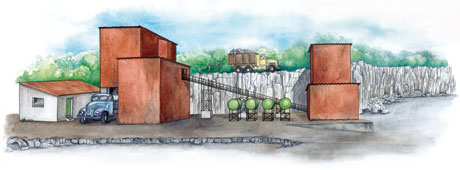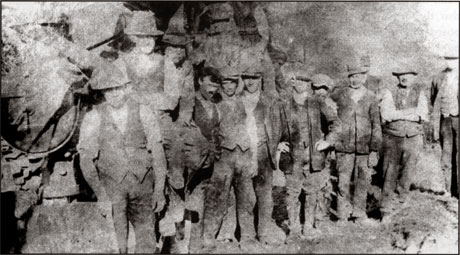
The image shown is an artist’s interpretation, based on an evaluation of the surviving structures and information provided by former workers of the quarry. The illustration shows a small single-storey building with a window and a lean-to roof, which would have been the control room for the works. There was an office with a weigh-bridge a small distance to the left of this. A roadway between the control room and the office lead to the top of the quarry. A steel-bedded truck ferried the quarried stone along this road up to the top where it deposited a load into the crusher from above. The crusher was extremely powerful and was shaft driven by a diesel engine housed in a structure to the front. The stone, now broken into pieces about the size of an orange, was taken on a conveyor belt to a second crusher or mill and ground to dust. The lime dust was lifted on a mechanised series of buckets up to a hopper where it was deposited, ready for delivery. A loading bay directly under the hopper allowed the 5-ton trucks to receive a full load before being weighed and transported out to farms. Most of the works were housed in structures covered in sheet metal.
Limestone is widely available throughout Ireland with varying types and quality. Quarries around this area were noted in Henry Fidler’s Table of Principal Limestone Quarries in Britain and Ireland (1875), as having top quality building stone. It also records that stone from local quarries was used for the bridge in Lanesborough. Quarrying in the local area goes back centuries with a number of now disused quarries noted on the ordnance survey maps. Throughout the 1800s it was common for quarries to be used as a source of stone for specific buildings, for example a church or bridge, and then closed. The remains of an old quarry can be seen at the edge of the woodlands, further along the walk.
More recently limestone was quarried here in Commons North, producing lime for agricultural use. The first of the two quarries in Commons North, leased from Tom Gill, opened in 1948 and was worked under the name of Agricultural Lime Ltd. William Conroy took over the lease of the quarry in 1952. The first quarry closed sometime in the mid 1950s as the quarried limestone grew closer to the Rathcline Road. The second quarry opened in the early 1950s and was worked until its closure circa 1960. William Conroy originated from the Dublin area and his company William J. Conroy Ltd. employed a number of local men to work the quarry as well as bringing in workers from outside the area.
The lime was transported by trucks, which were mainly run by CIE, however eventually William Conroy acquired two trucks and hired his own drivers. Two pairs of drivers worked consecutive shifts, delivering lime to the local farms within a 20-mile radius.
The rock was blasted using gelignite made active with detonators and placed in holes drilled into the top of the rock. In the early years the drills would have been hammer-driven by hand and it would have taken a long time to drill to any depth. These holes would have been 2-inch wide and probably no deeper than a couple of feet. Later, with the introduction of more advanced power drills, the sticks of high explosive were placed in 4-inch holes bored to a depth of 20ft into the top of the rock about 8ft from the edge and about 10ft apart. This would open up enough quarry to provide about a weeks worth of stone to process.
Larger rocks, deemed too big for the crusher, had to be broken at the foot of the quarry. This was done with much hard work using sledge hammers in the early years. Later these large rocks were plaster blasted or secondary blasted at the foot of the quarry before being sent to the crusher. The gelignite was kept under lock and key in a magazine—a small secure storage shed—on the opposite side of Rathcline Road. The gelignite was brought from Dublin to Longford town by train and a Garda escort was required to collect it and bring it back to Lanesborough. There were no accidents as far as history records but there was a regular occurrence of damage to the roof of Gill’s house nearby due to stray rocks. On one occasion a strong blast in the quarry broke windows across the river in Ballyleague.
Blasting went on during the daytime. Stone was transported from the second quarry, by a large steel-bedded truck, to the first quarry where the crusher, mill and hopper were situated. These would run overnight so work went on around the clock. The first crusher broke the stone down to small rocks which were taken by conveyor belt to a second crusher where they were milled into a lime dust suitable for spreading on farmland. The busiest time was October or November, (depending on the weather) through to March, as this was the time the farmers needed lime for their land. Throughout summer preparation work was done with a little quarrying—operated using only a skeleton staff.
Lime was transported in small 5-ton trucks such as the Ford Costcutter, which at times often took 8 tons or more for delivery to farms—this could cause problems driving up steep hills. The lime was not bagged but loaded directly into the lorries, which were then weighed on a weigh-bridge within the quarry. It would have been sprinkled with water to reduce the dust clouds from the lime during transportation.
The lime was sold to farmers at a cost of 17/6d per ton, however, William Conroy was match funded by the State and so took a total of £1.15s per ton. In this way he could afford to be lenient to farmers who could not pay up immediately for their lime.
In the late 1950s there were approximately 12 people working in the quarries, including a foreman, a clerical officer, machine maintenance worker, an explosives setter, two salesmen and four drivers. The salesmen covered areas in and around Longford, Roscommon and Westmeath. They would obtain a list of farmers from the agricultural office who required lime. However in later years when needs may have been greater, they might do “cold calling” and visit all farmlands to build on their lists for sales.
It is not clear exactly when the second quarry closed, but it was around 1960 and probably due to the quarry growing closer to the road where houses were starting to be built. The control room and the pillars that held the crusher, engines, conveyor belt, mill and loading bay are all that is left of the quarry works today.

The Quarry
by Seamus Kelly
Leave Lanesborough town and just come down
To see John Gill’s great quarry;
Then stay awhile, see how we toil
It’s a heavy cross we carry.
At eight o’clock the tool box lock
Is opened by the foreman;
The work we do the whole day through
Leaves each of us a sore man.
The engine roars, the rock it bores:
Is it any wonder
When by and by, the stones shoot high?
That face is rent asunder.
Again we leap upon a heap
Of broken rock and rubble.
Some swing the pick and mighty quick,
While others work the shovel.
The crow bar dings, the hammer sings
Upon some great big boulder.
At every stroke until it’s broke,
You don’t feel anything colder.
But if you try until you die,
You will not sledge like Beirne;
He has the knack, you must keep back
Ah, his money he does earn!
Then Fallon, Quinn, two stalwart men
Come all the way from Moher;
They never fail each day they sail,
Sure no men could be tougher.
And Mick McCann, the little man,
Comes up from Tarmonbarry;
Connolly, too, to him ’tis true,
They’ve no soft jobs in the quarry.
Brave Paddy Cox, cute as a fox,
His pay is now ten bob;
He serves the tea and you’ll agree
That Paddy’s is no soft job.
Wind or gale, snow or hail,
In any kind of weather,
The Walshes work, they do not shirk
Tom and his younger brother.
George comes at eight, he’s never late,
No worker could be smarter;
Then like a black he will attack,
He is the only carter.
As you know from Curraghroe
Tim Farrell comes each morn;
He has not seen where e’er he’s been
Such work since he was born.